Click on images to enlarge
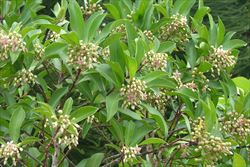
habit in flower (Photo: Sheldon Navie)
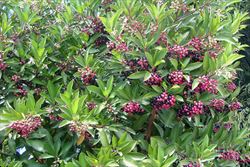
habit in fruit (Photo: Sheldon Navie)
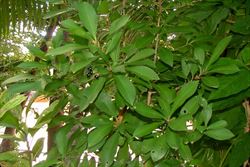
habit growing in a shady position (Photo: Sheldon Navie)
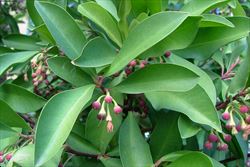
leaves (Photo: Sheldon Navie)
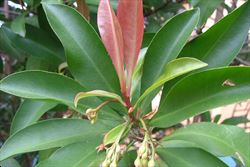
reddish-coloured young leaves (Photo: Sheldon Navie)
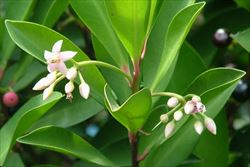
flowers and flower buds (Photo: Sheldon Navie)
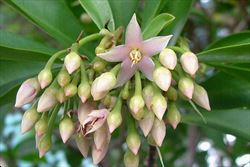
close-up of flowers (Photo: Sheldon Navie)

young fruit (Photo: Sheldon Navie)

immature fruit (Photo: Sheldon Navie)

mature fruit (Photo: Sheldon Navie)
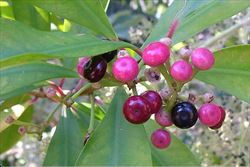
close-up of mature fruit (Photo: Sheldon Navie)
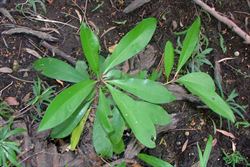
young plant (Photo: Sheldon Navie)
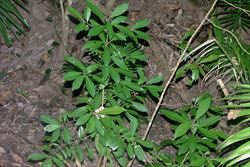
infestation in a rainforest understorey in northern Queensland (Photo: Sheldon Navie)
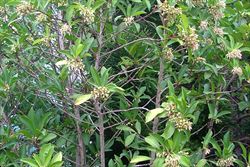
habit of cultivated plants growing in a sunny position (Photo: Sheldon Navie)
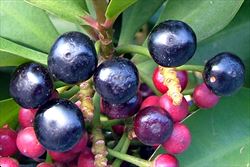
close-up of mature fruit (Photo: Sheldon Navie)
Scientific Name
Ardisia elliptica Thunb.
Synonyms
Ardisia humilis Vahl (misapplied)
Ardisia solanacea Roxb. (misapplied)
Family
Myrsinaceae
Common Names
ardisia, China shrub, duck's eye, jet berry, shoebutton, shoe-button ardisia, shoebutton ardisia
Origin
Native to the Indian Sub-continent (i.e. southern India and Sri Lanka) and south-eastern Asia (i.e. Taiwan, Cambodia, Thailand, Vietnam, Indonesia, Malaysia, Papua New Guinea and the Philippines).
Cultivation
This species has been widely grown as a garden ornamental in the warmer parts of Australia.
Naturalised Distribution
Naturalised in northern, central and south-eastern Queensland (i.e. recorded from the Cook, South Kennedy, Wide Bay and Moreton districts) and in the coastal districts of the Northern Territory.
Also naturalised overseas in south-eastern USA (i.e. Florida), the Caribbean, the Mascarene Islands, the Seychelles, and on several Pacific islands (e.g. the Cook Islands, Western Samoa and Hawaii).
Habitat
Shoebutton ardisia (Ardisia elliptica) is a weed of tropical and sub-tropical regions and mainly grows in wet forests (e.g. rainforests), riparian areas and disturbed sites. It is very shade-tolerant and is commonly found in shaded habitats, but can also grow quite happily in open areas.
Habit
A branched shrub or small tree usually growing 1-4 m tall, but occasionally reaching up to 6 m in height.
Distinguishing Features
-
a branched shrub or small tree usually growing up to 4 m tall.
-
its alternately arranged leaves are reddish in colour when young and have entire margins.
-
its flowers (6-13 mm across) are borne in clusters in the upper leaf forks (i.e. axils) of the main branches.
-
these flowers have five pinkish petals and their outer surfaces covered in tiny black spots.
-
its rounded 'berries' (5-9 mm across) turn from green to red when still quite immature, and eventually turn deep purplish or black at maturity.
Stems and Leaves
Undamaged plants in forest habitats are characterized by a single main stem, producing short, spreading branches. Younger branches (3-7 mm thick) are prominently angled and hairless (i.e. glabrous).
The simple leaves are alternately arranged along the stems and borne on stalks (i.e. petioles) 5-20 mm long. These leaf stalks (i.e. petioles) are either green or reddish in colour. The leaf blades (6-20 cm long and 1.5-7 cm wide) are oval or somewhat elongated in shape (i.e. elliptic or oblanceolate). They are somewhat leathery in nature, have entire margins, and have pointed or somewhat rounded tips (i.e. acute or obtuse apices). The leaves are also hairless (i.e. glabrous) and young foliage is often reddish in colour.
Flowers and Fruit
The flowers are borne on small branches (3-8 cm long) emanating from the upper leaf forks (i.e. axils) of the main branches. The bases of the flower stalks (i.e. pedicels) are clustered together at or near the same point towards the end of the flowering branches (i.e. umbellate to racemose axillary inflorescences). These flower stalks (i.e. pedicels) are 1-2 cm long and are covered in tiny black spots (i.e. they are punctate). The flowers (6-13 mm across) usually have five small sepals (1-3 mm long) and five petals, both of which also have their outer surfaces covered in tiny black spots (i.e. they are black punctate). The petals are pale pink, pale lavender or whitish in colour, somewhat leathery in nature, and are slightly joined together at their bases. These petals (up to 9 mm long) are somewhat elongated in shape (i.e. lanceolate) with pointed tips (i.e. acute or attenuate apices). The flowers also have five yellow stamens that surround a slightly longer style topped with a tiny pointed stigma.
The fleshy fruit (5-9 mm across) are rounded (i.e. globose or sub-globose) 'berries' (actually drupes) that quickly turn from green to red when still quite immature. They eventually turn deep purplish or black in colour at maturity and contain a single round hard seed (about 5 mm across) surrounded by a whitish coloured pulp.
Reproduction and Dispersal
Shoebutton ardisia (Ardisia elliptica) reproduces only by seed. Fruit-eating (i.e. frugivorous) birds and other animals, which are attracted by the numerous bright red to blackish fruit, are the principal dispersal agents of this species. Its fruit may also be dispersed in dumped garden waste.
Environmental Impact
Shoebutton ardisia (Ardisia elliptica) is regarded as an environmental weed in the Northern Territory and Queensland. This shade-tolerant plant grows rapidly and forms dense monotypic stands that prevent the establishment of all other species. At Nhulunbuy, in the north-eastern parts of the Northern Territory, it has formed dense thickets in monsoon vine forests and melaleuca woodlands which have displaced native groundcover and understorey plants. Naturalised specimens have also been spotted growing in riparian vegetation within areas of dry rainforest. In northern Queensland it is particularly problematic around Cairns, where it is invading natural areas around the city.
This species has become naturalised relatively recently and is considered to be in its early stages of spread in Australia. However, it appears well suited to the monsoon zone of northern Australia as well as the tropical and sub-tropical coastal districts of eastern Australia. It already has a foothold in all of these regions, and if it were to reach its potential distribution it would be at the significant expense of indigenous species.
Shoebutton ardisia (Ardisia elliptica) already has a significant reputation as an invasive species in other parts of the world. It is listed in the Global Invasive Species Database, where it is regarded to be among the top 100 of the world’s worst invasive alien species. It forms dense single-species stands under trees in wet sites in Florida, Hawaii, and Puerto Rico that suppress native understorey plants. Due to its high reproductive output and high shade-tolerance, very dense carpets of seedlings can form underneath adults in ideal conditions (i.e. more than 400 plants m2). In Florida it is also abundant in hammocks, old fields, disturbed wetland, marshes, cypress communities and mangrove areas. Its invasiveness has led to it becoming an eradication target by natural resource managers in conservation areas in Florida (e.g. in Miami-Dade and Broward County Parks and in the Everglades National Park).
Legislation
Not declared or considered noxious by any state government authorities.
Similar Species
Shoebutton ardisia (Ardisia elliptica) is very similar to Ardisia solanacea and Ardisia humilis, and these three species are considered to be a single variable species by some botanists (i.e. they are sometimes included within Ardisia elliptica). It is also relatively similar to coral berry (Ardisia crenata), and these two species can be distinguished by the following differences:
- shoebutton ardisia (Ardisia elliptica) has leaves with entire margins. Its fruit turn black or purplish-black when fully mature.
- coral berry (Ardisia crenata) has leaves with slightly toothed (i.e. crenulate) and wavy (i.e. undulate) margins. Its fruit usually turn bright or dark red when fully mature.
There are also several native ardisia species (Ardisia spp.) present in the rainforests of northern Australia.

